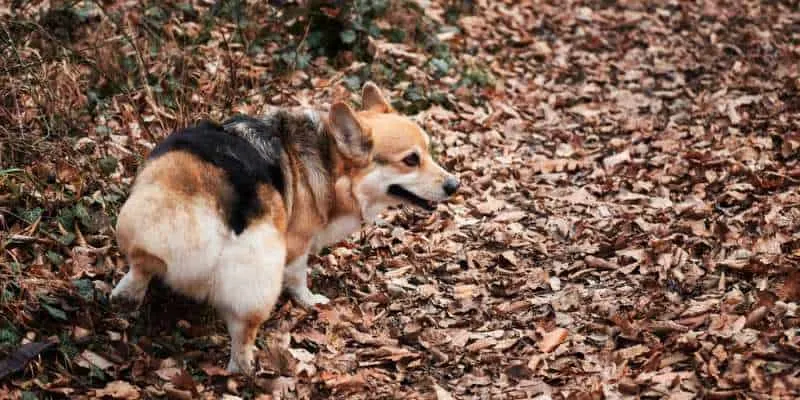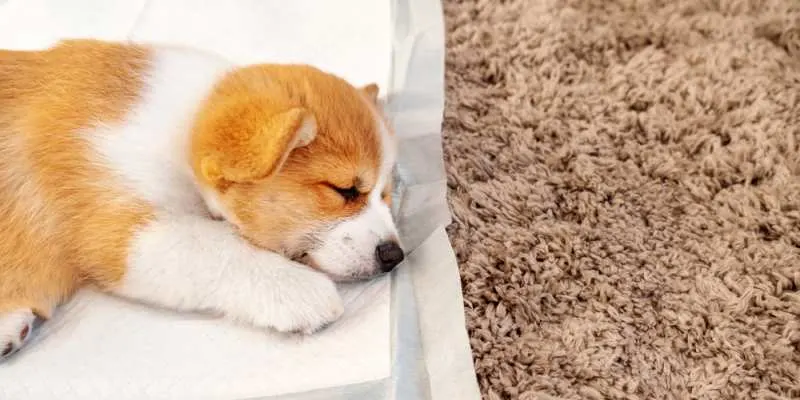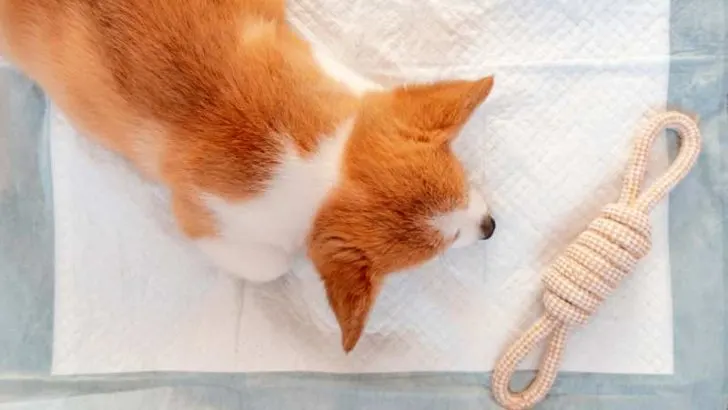If there’s one thing that all dog owners have been through unanimously – it’s the potty training period. Young puppies can’t control their bladder well, so we all stumbled upon little ponds of urine left all over every room in the house.
So how should you deal with this? Well, there are many schools of thought. Some people say that you should get your puppy used to going number one (and two) outside as soon as possible. But what do you do when that’s not an option?
Corgis have those tiny legs, and you can’t really rely on them to go running outside every time they need to go! Especially if we’re talking about small puppy Corgis. That bladder will maybe reach the hallway on a good day. So should you just carry them everywhere?
Sure, it’s an option, but there must be a better way. Well, pee pads are an option that many people consider, which makes sense. It saves you the hassle of taking your puppy out every 15 minutes, and your Corgi doesn’t have to keep it in all the time!
Well, because it’s such a popular method, we made a little guide. The “How to train your Corgi to use a pee pad” guide, to be more precise! We know it’s a mouthful. But stick with us, you’ll learn everything you need to know, we promise:

The Ultimate Pee Pad Training Guide For Your Corgi
The first thing we need you to know about this whole situation is why your Corgi is leaving its mark all over the place, so to speak. Well, it’s simple – they can’t hold it in. Every puppy has this problem, heck, humans do too!
Their bladder is small and weak, which means that it fills up pretty darn fast. This, in turn, means that your puppy needs to get rid of the liquid even faster. After all, there’s always more coming in as these little creatures need to stay hydrated at all times.
So can a pee pad help, you ask? Yes it can! Let us explain.
While your puppy should eventually start to go outside to perform his natural duties, making them do this at just a couple of months old is a kind of torture. In addition, young puppies need to pee about every 15 minutes, though this is dependent on your particular dog.
But let’s say that it’s every half an hour, that’s still too much. It makes no sense for you to keep running out with your dog 30+ times per day. That’s where the pee pad comes in.
Once you teach your Corgi to use the pad, you’ll be more relaxed knowing that you won’t step into a pee puddle ever again! Well, never again is a bit of an exaggeration – accidents do happen after all. But keeping the number close to a minimum is what we’re aiming for here.
It’s not going to be a simple process; let’s get that clear. And it will get annoying at times – but it will most definitely be worth it! We just have to mention that there is a difference in how you train a puppy versus how you train an older dog who has bladder problems. But we’ll cover them all, don’t worry.
Training Young Corgis
As we already mentioned, puppies might need to go to the bathroom as often as every 15 minutes! Unfortunately, this means that training them requires you to be home all day long.
It may seem like it’s a bit much, but remember, their bladders are still incredibly small, and the muscles that are needed to keep the urine in just aren’t strong enough yet. So they’ll get there, don’t worry, but it takes time.
Here’s how it works.
The first thing you’ll need to do is buy training pads. They come in many sizes, and you should make the decision based on the size of your house/apartment. Then, once you get them, you need to figure out where to put one.
The location of the pad shouldn’t be in the most obvious place in the room -this is a mistake that many people make! Your puppy wants privacy, they really don’t enjoy peeing indoors, so when they do it, they need to know that no one is looking.
This doesn’t mean that they don’t need supervision; on the contrary. But they need to feel like they have their own little spot that they can count on. So putting the pad in a corner that you or your housemates don’t often walk past is usually the best option.
Some dogs pee on the pad right away but don’t expect this to happen. It’s more likely that your Corgi will need some time to get used to where it is, how it smells, and what it’s for. Again, positive reinforcement is the golden ticket in this stage, and it can really speed up the whole process.
This is why you’ll need some heavy-duty traits to help reinforce the behavior you want from your puppy. Most pet stores have many treat types that you can buy, but we suggest going for those with less sugar.
After you set everything up, the actual training gets quite simple but time-consuming. Every fifteen minutes or so (in the case of young puppies), take your Corgi to the pad. Leave it there to smell around and try to figure out what could be happening.
You need to figure out when it needs to go to the bathroom, which may seem complicated but isn’t. They need to go a lot of times during the day, so just wait for them to do it, and then wait approximately 15 minutes to carry them to the pad.
If you want, you can put a leash on your Corgi and kind of walk them over there. This will help ease the transition to when they’ll need to start going outside to pee.
It’s a hit-and-miss process. Once your Corgi manages to pee on the pad, reward him. This will make the connection in its head between the action, location, and reward.
You’ll still catch your dog peeing in some random spot in the house; that’s a guarantee. This is because they can use their powerful noses to locate where they already urinated! So they come back to mark the territory once again, so to speak. This happened with males more than it does with females, but it could be more than just marking.
It’s simple, they urinated on the spot already once before, so when they find that smell, they think that that’s the spot for peeing!
This is the type of connection that we’re trying to make with the pee pad. They will eventually remember the smell of the pad and connect the location of it to peeing. The smell is actually more important since dogs that got trained to use pads usually feel like using them later in life, no matter where they find them.
That’s pretty much how it’s done; you just need to redo these steps every day, all day! That’s the annoying part, well, that and the fact that it may take time to do. Then, just when you think that your Corgi figured it out, you find that you stepped in a small puddle, and your Corgi is looking at you, unaware of why you’re so mad.
Learn More: Are Corgis Trainable? How Long To Train A Corgi?

That brings us to a very important segway:
Never Punish Your Puppy
The most important thing you mustn’t do during this process is punishing your dog for peeing indoors. We know that it can be infuriating, but this will do more harm than good!
You see, dogs don’t remember what they did once you start yelling at them, and if they do remember – they learn to be afraid of it. So making you red hot mad is the last thing your puppy wants to do.
So if you start yelling or punishing your puppy in any way, your Corgi won’t know what’s happening, but it will know that it’s scared. See, dogs can’t learn to not pee; it’s a bodily function after all. So when you punish them for peeing, the best they manage to understand about the whole situation is the location.
This means that your dog will continue to pee in the house, but it will start hiding out of fear while it’s doing it. It is incredibly unhealthy for a dog to be afraid of a natural bodily function!
The only way they will learn where to pee is to reward them once they hit the spot! Punishing does a lot of harm and not good whatsoever. So if you do catch your puppy peeing in the closet a day after it managed to figure out what the pad is for – take a deep breath, calm down and carry it to the pad.

Training Older Dogs
Veteran Corgis, like all older dogs, have the same problem that the puppies have when it comes to urinating. Well, not the exact same one, but almost! Their bladder just can’t seem to hold it in as well as it used to.
There’s nothing wrong with that; it’s completely natural. But it means that you’ll probably need to teach your dog to pee on the pad. But, on the other hand, it’s going to make them feel a lot better when they can’t hold it in any longer, that they have a safe spot indoors, and that that they won’t have to wait for you to let them out!
The process is pretty much the same for older dogs as it is for puppies. First, find a place for the pad where your Corgi will have some privacy. Then, keep an eye on them so you can learn how often they need to pee. Next, walk them over to the pad every once in a while so they get used to it. And reward them when they do it!
Just don’t worry about that saying that old dogs can’t learn new tricks – it’s a complete myth! As long as you’re persistent, your Corgi can learn anything you throw at it!

Final Words
So there you have it! Using a pee pad in the house is a great way to teach your Corgi what the house is for! Their instinct will tell them not to pee where they eat or sleep, for instance, but they won’t be able to figure out the rest on their own!
So buckle up, and get ready to start teaching them what’s what. Potty training is the basis for everything that they will learn in the years to come. So if you want a smart and well-behaved Corgi – get cracking!

